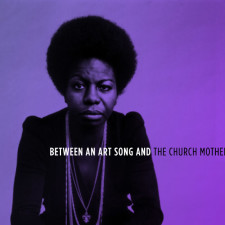Rarely does the public regard great musicians, dancers, or athletes as great intellectuals. This is quite surprising considering that, after all, the brain is a vital part of the body and plays a crucial role in orchestrating its accomplishments. Therefore, while we certainly should appreciate the physicality of Michael Jordan’s gravity defying dunk or the absolute beauty of Karen Clark-Sheard’s vocal virtuosity, in order to truly understand the depth of their artistry, it is time to take a closer look at intellectualism of an embodied performance.
The song “I’ve Got No… I’ve Got Life” (1968) by legendary musician and social critic Nina Simone proves the point. Through the lyrics and the way Simone articulates them, the song emerges as a musical theorization of the body as the essential source of a lived experience. Its first part combines a minor mode groove with a text that accounts the absence of possessions such as home, money, and friends. Next a vamp questioning, “What do I got?” leads into the second part played in a major mode chord cycle while Simone names different body parts that she owns. Now her earlier short speech-like vocals have transformed through increased breath support into vibrato filled phrases about the makings of humanity. Although Simone’s facial expression reveals little emotion, her strong fingers on piano keys speak volumes for herself and each of her listeners: before anything else, it is the embodied existence that defines our physical and social world.
In the American sports history, Jack Johnson holds a formidable place as the first black world heavyweight boxing champion. He is possibly the greatest athlete of the early 20th century but, unfortunately, the intellectualism underlying his success remains unrecognized by the mainstream public. As Davarian Baldwin notes in his book Chicago’s Newest Negroes: Modernity, The Great Migration, and Black Urban Life (2007), Johnson’s success was not only based on his dominating physicality. His adroit boxing style and psychological strategy in the ring were unmatched. What’s more, outside of the ring Johnson’s display of arrogance and lavish lifestyle constituted a skillful rhetoric of agency and resistance. It is also worth noting that among Johnson’s African American supporters, his success spurred social consciousness and radical questioning of racial hierarchies in the society.
Dancer, choreographer, anthropologist, and social activist Katherine Dunham’s work also brilliantly demonstrates intellectualism in an embodied performance. To this end, her ballet Shango (1945) is a fascinating example as it integrates movement and sound with elements from her study of social and ritual customs of different Caribbean societies. In the opening scene, human screams pierce through a dusky ambiance, while dancers rush into the stage in anticipation of a sacrifice of a white cock. This leads into a communal possession experience in which the dancers in white costumes sketch the sacrificed animal’s image in fluid movements that simultaneously demonstrate surrender to trance and bodily control. Their varied motions project powerful visual and kinesthetic imagery that draws equally from Dunham’s artistic imagination as well as her field research. Reading Dunham’s dance alongside her scholarly work enables us to understand Shango as a multilayered African diasporic text.
Simone, Johnson, and Dunham are true masters of embodied discourses and the examples of their accomplishments urge us to reconsider the interconnectedness of intellectuality and physicality. This new perspective can offer us a deeper understanding of the ideas of pioneering cultural figures. Furthermore, the consequence of this orientation can be groundbreaking. Ultimately it will serve to debunk the unnecessary dichotomy of body and mind by replacing it with a celebration of their superb synergy as the mark of the highest artistry.
Tags: Chicago, dance, Jack Johnson, Katherine Dunham, Nina Simone, Shango, sports, The Chicago Project

 Share On Facebook
Share On Facebook Tweet It
Tweet It







